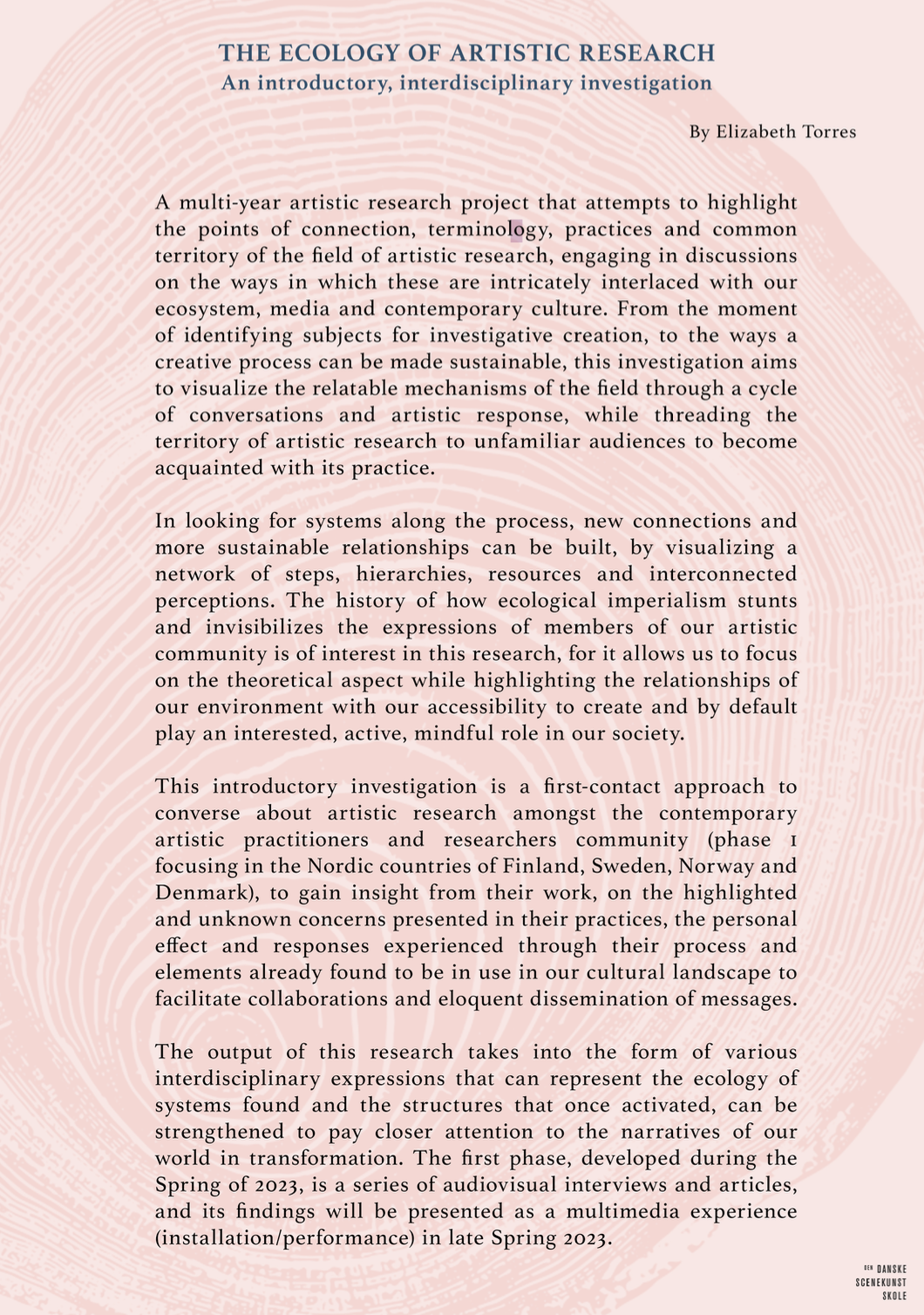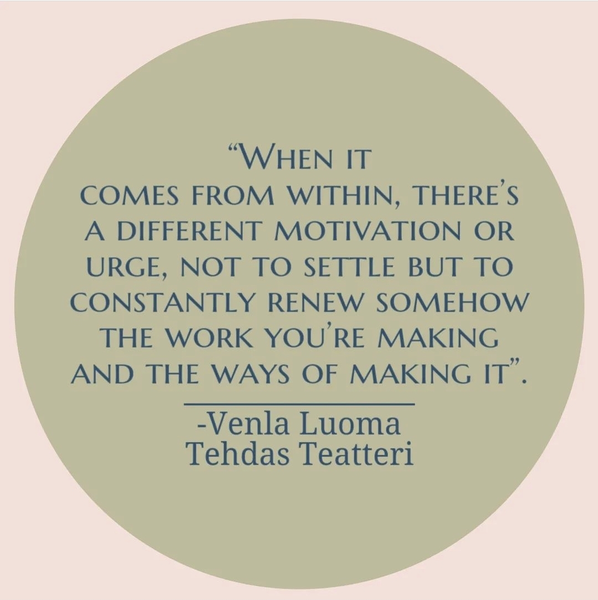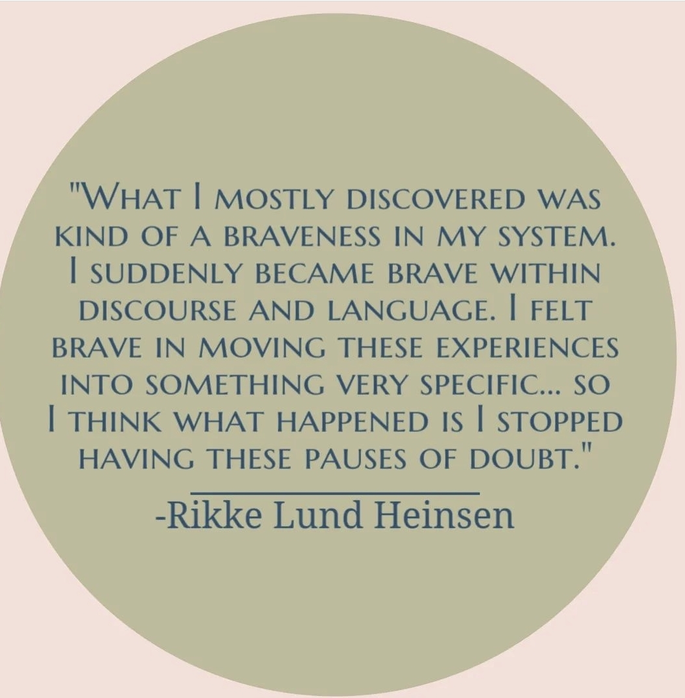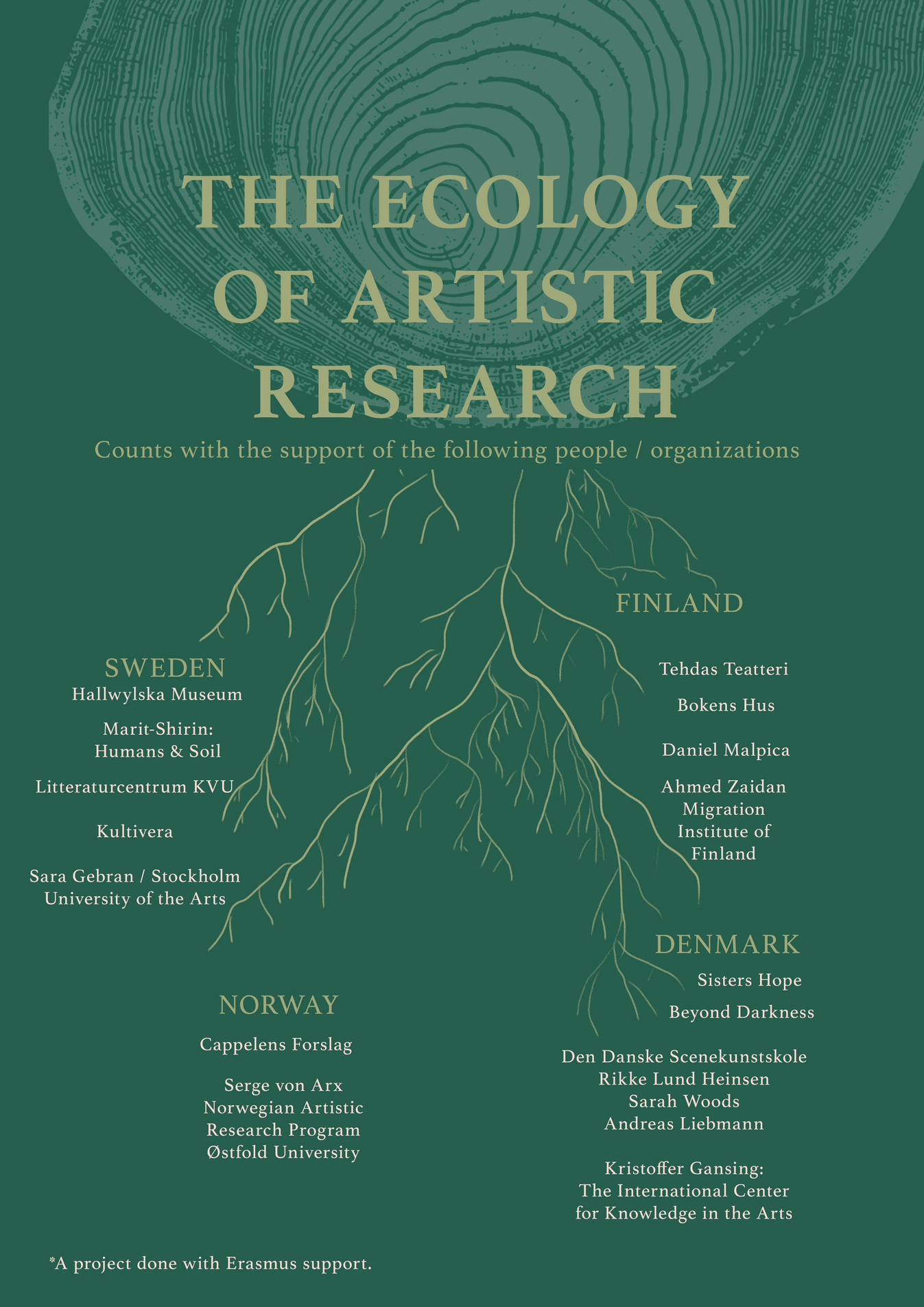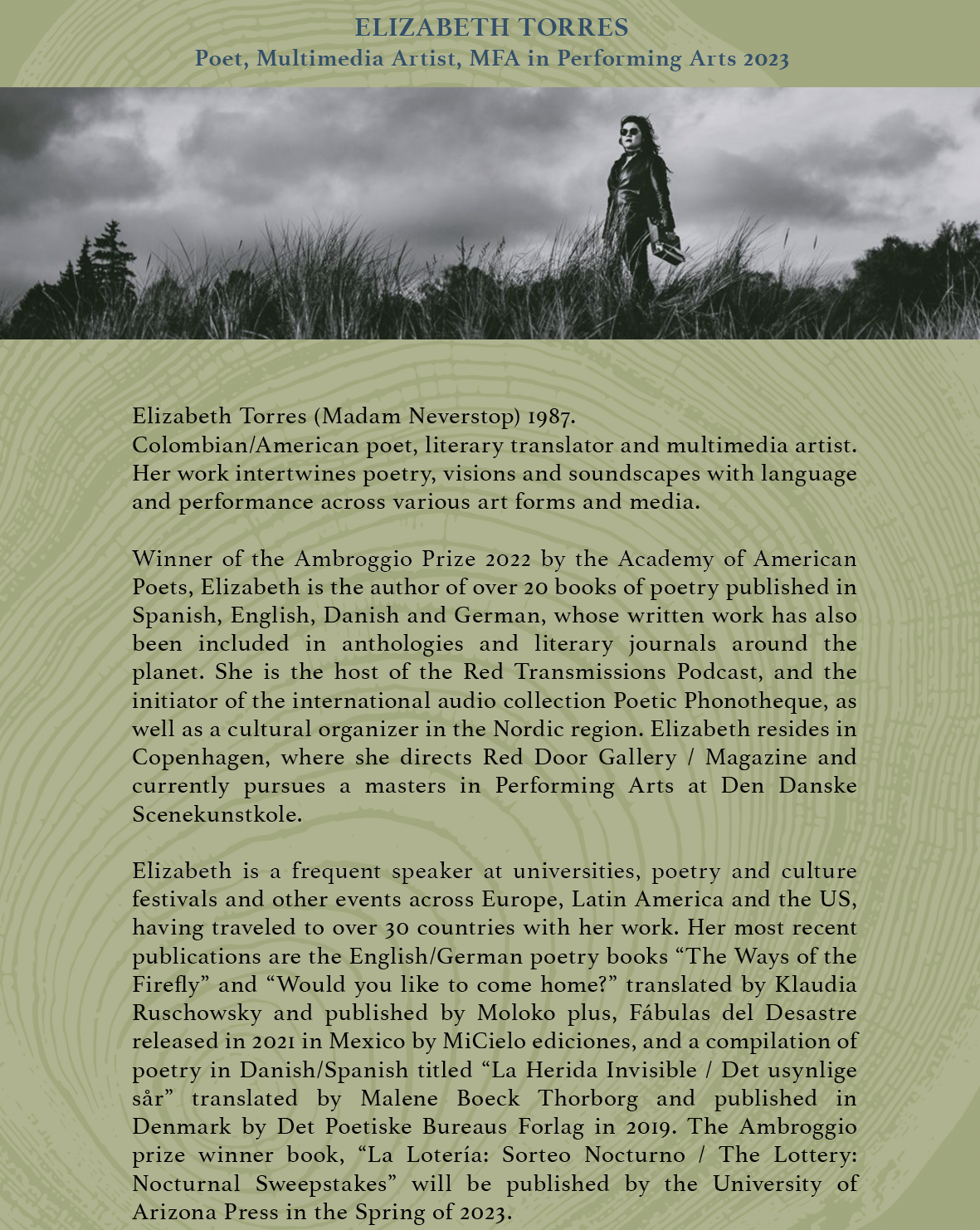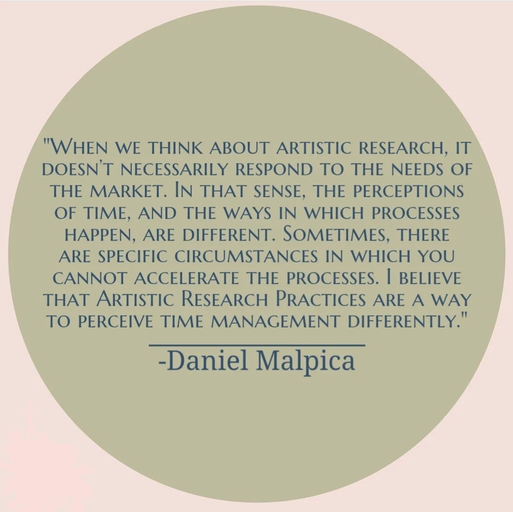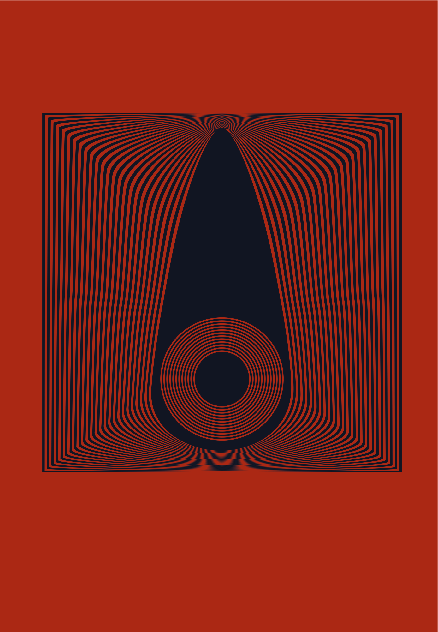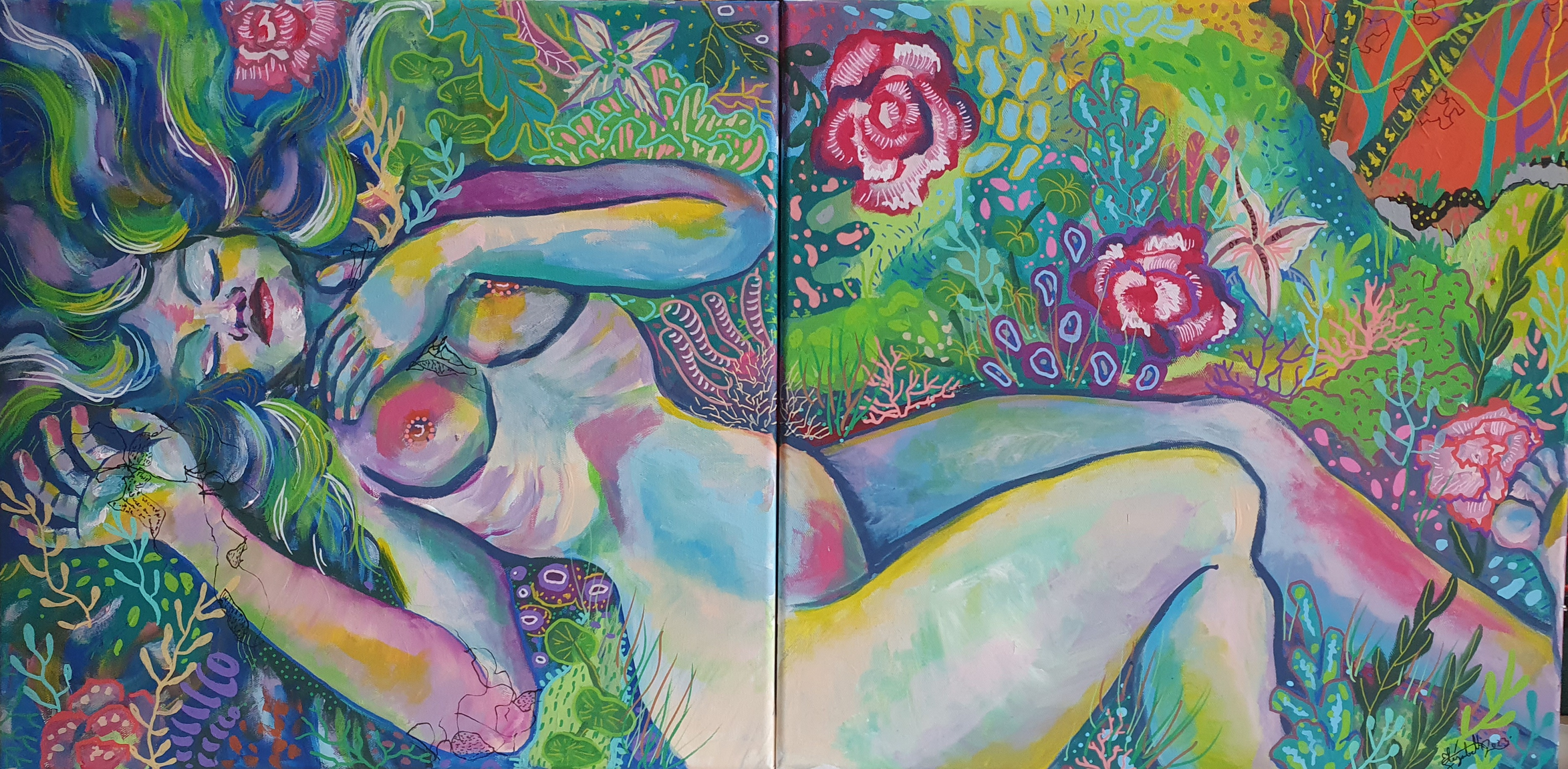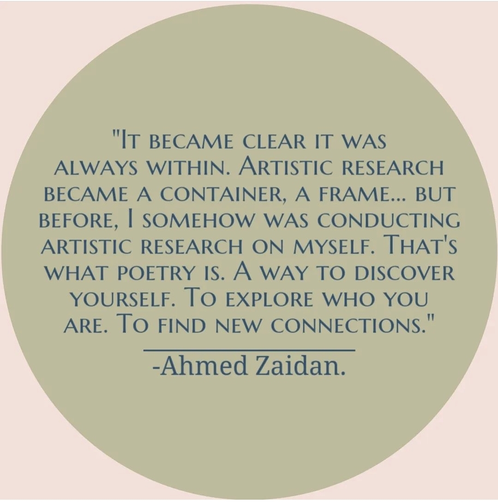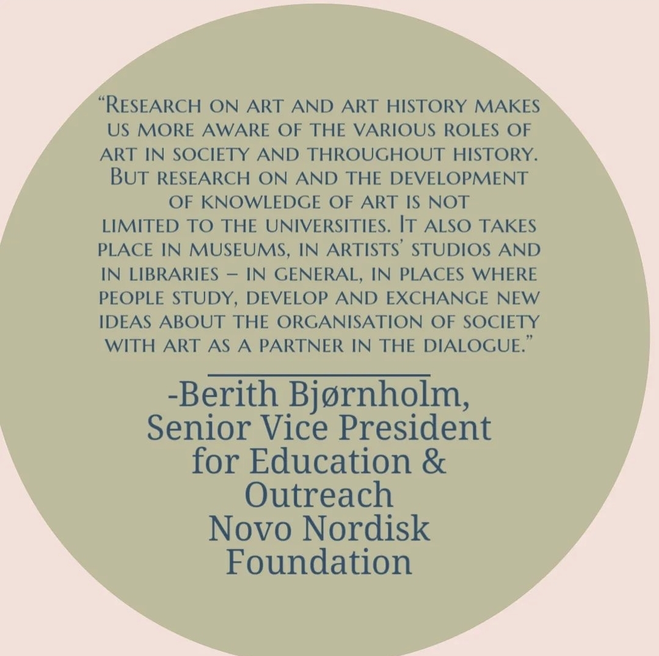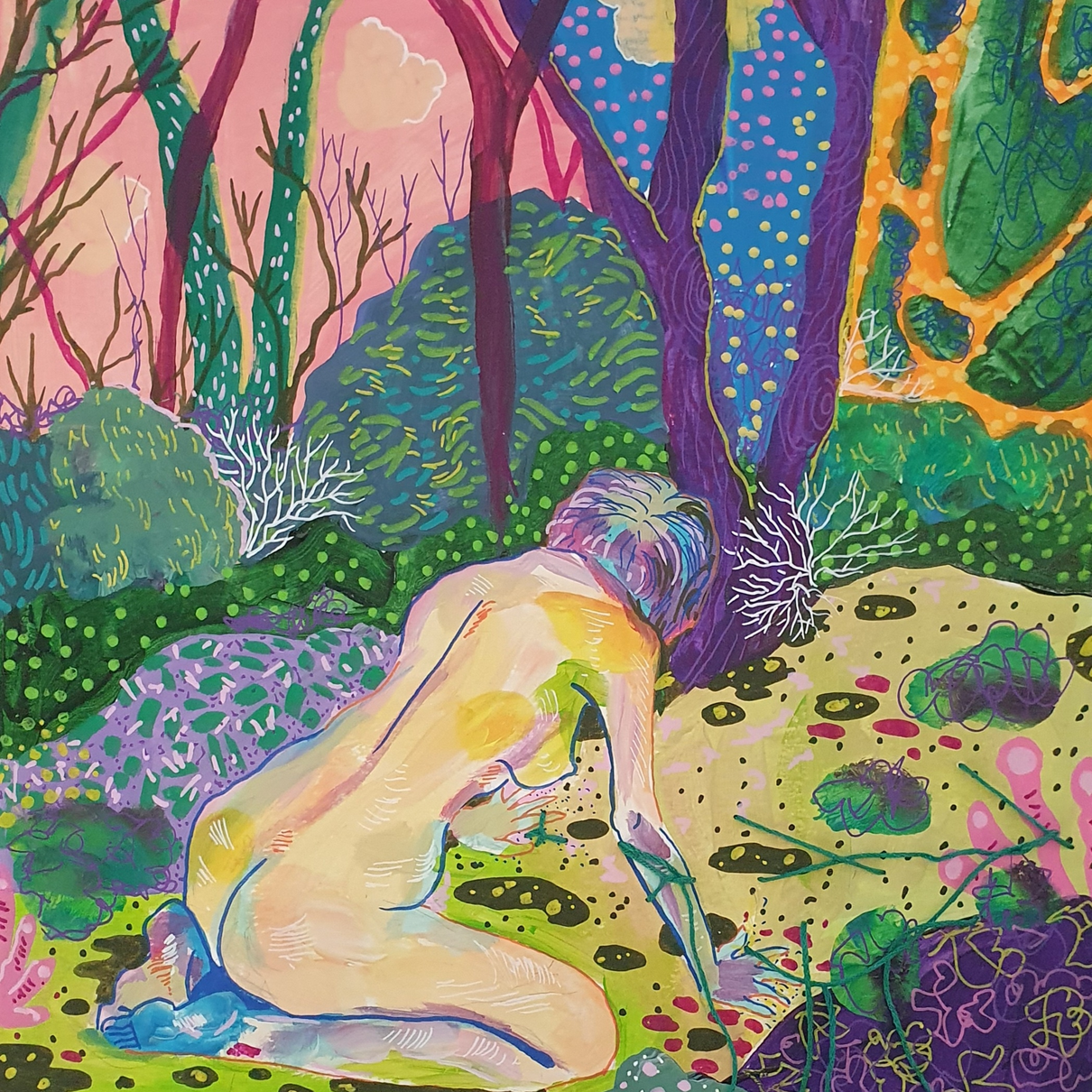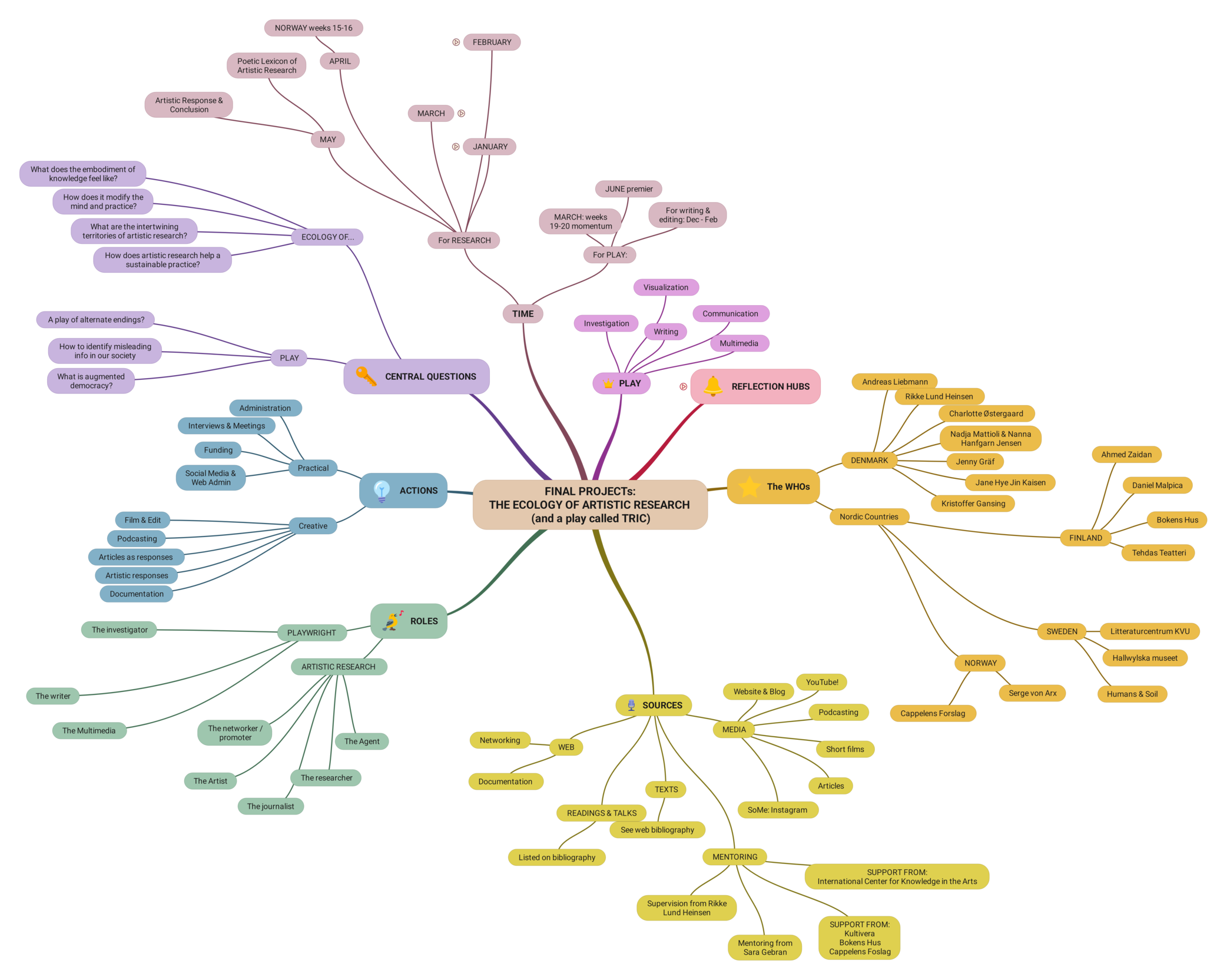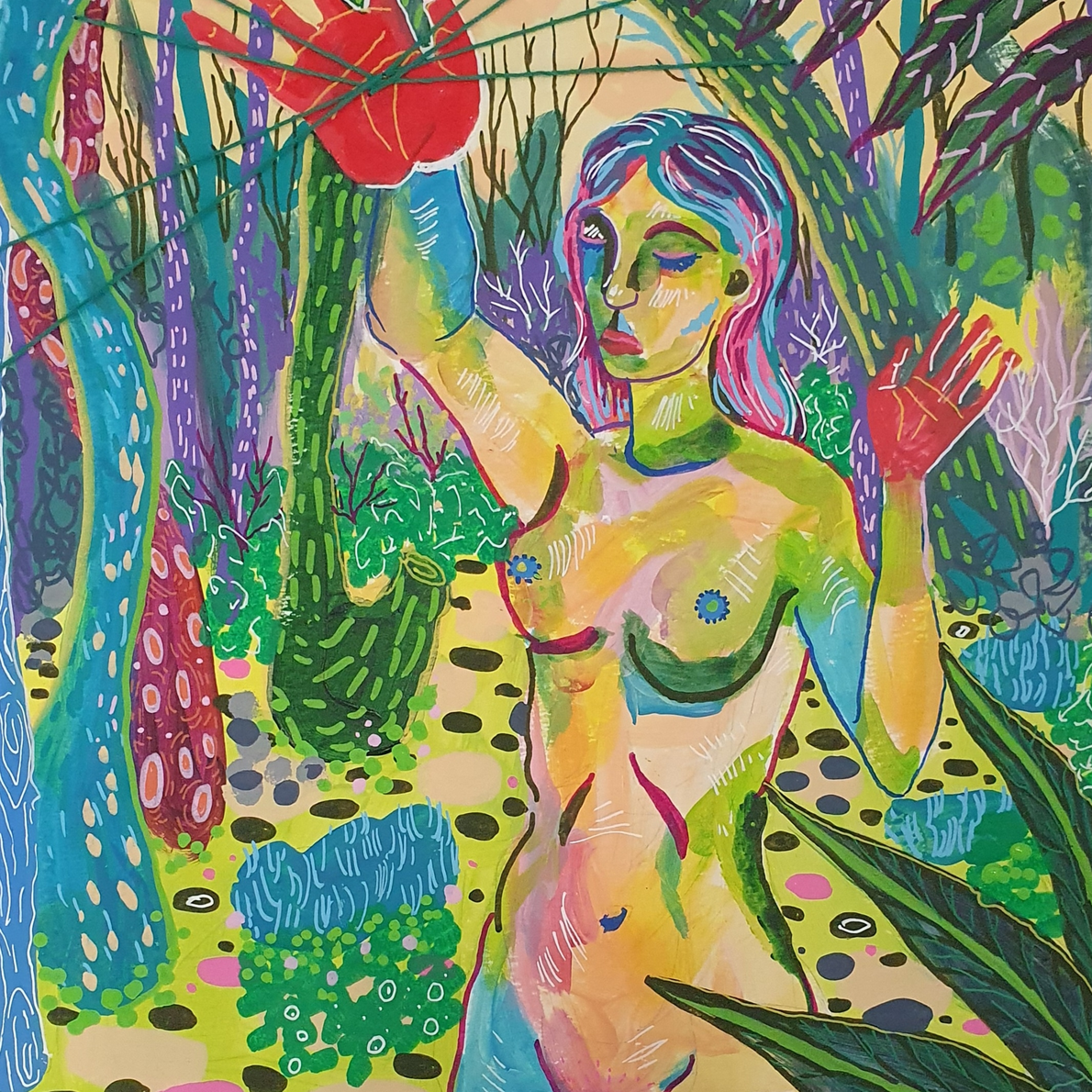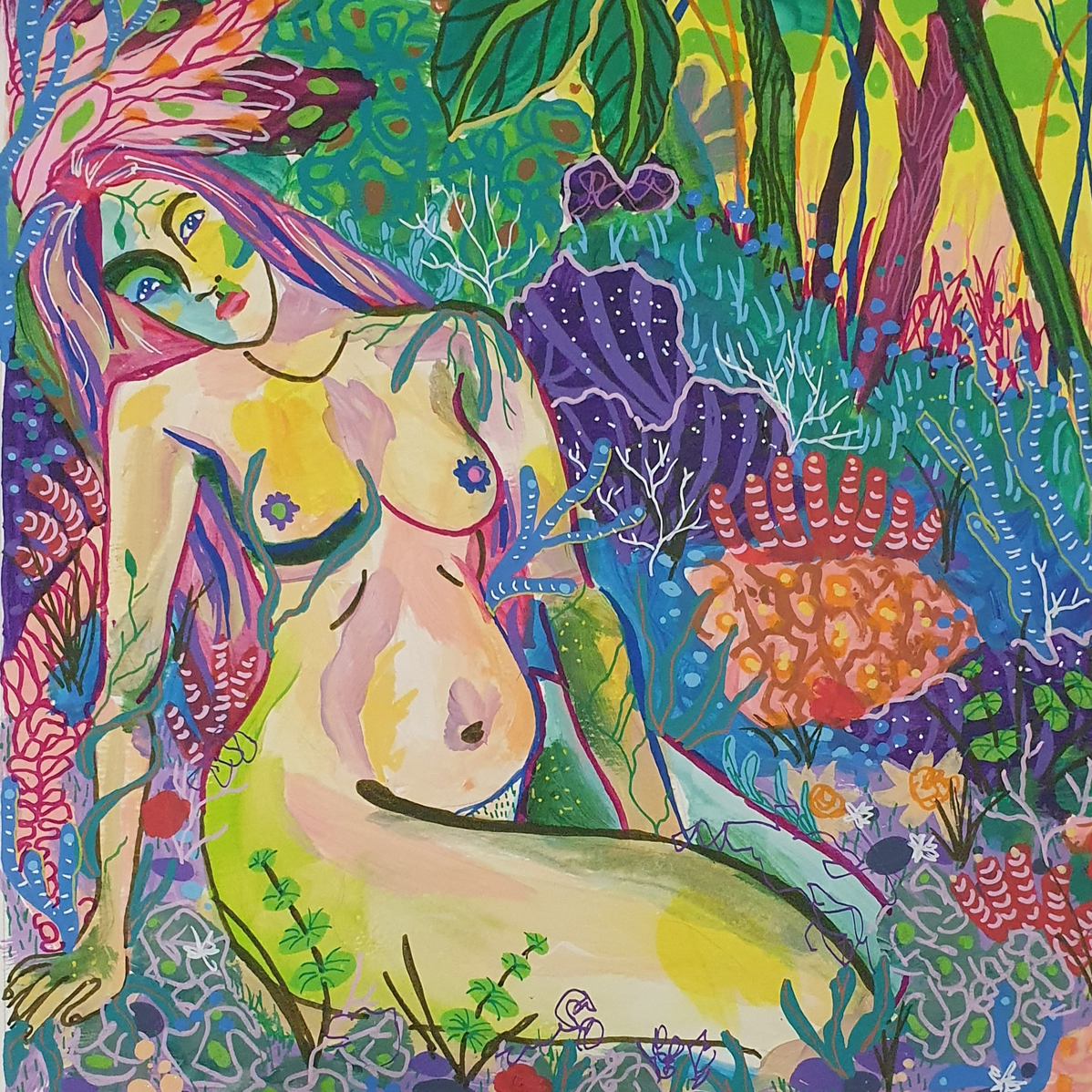DENMARK:
The interviews conducted in Denmark served as a crucial starting point and foundation for the investigation, given that it is the researcher's home base. The insights gained from conversations with contemporary artistic practitioners and researchers such as Sisters Hope and Phantoms of Stability provided encouragement to guide the inquiry lines of the project.
Through this initial engagement, the project was able to identify key areas of inquiry and establish a framework for exploring the intersections between artistic research, sustainability, and environmental concerns. As such, the interviews in Denmark played a significant role in shaping the direction and scope of the investigation, and remain an essential component of the project's overall research approach.
Rikke Lund Heinsen: Producer, essayist, artistic researcher and associate professor at DDSKS.
Please hover over the image to read article OR click on image to watch the entire interview.
In this interview we speak about her transdisciplinary work and how this is where she feels most at home, but also how artistic research has expanded this practice, through a project within DASPA called Semper Plus Ultra (Always Beyond This), where she sought to find significantly different work spaces within Performing Arts, an expanded version that would allow for greater exchange of knowledge and being able to ask important questions.
Sisters Hope: Gry Worre Hallberg operates in the intersection of performance art, research, activism and educational development continuously executed in 1:1 co-created experiments such as Sisters Academy, Dome of Visions, and In100Y. She is behind the vision and movement Sensuous society and for many years she has aimed at enriching environments with an aesthetic dimension through interventionist, interactive and immersive performance art strategies. Gry is the co-founder of a range of organizations and movements within the field of performance art applied in a series of different everyday-life contexts, among them Sisters Hope (ongoing project: Sisters Academy), House of Futures, Fiction Pimps, Club de la Faye, Staging Transitions and The Poetic Revolution.
Please hover over the image to read article OR click on image to watch the entire interview.
Kristoffer Gansing is professor of Artistic Research and director of the International Center for Knowledge in the Arts.
Please hover over the image to read article OR click on image to watch the entire interview.
Andreas Liebmann: Performance artist, writer, director. Lecturer at DDSKS.
Please hover over the image to read article OR click on image to watch the entire interview.
One of my central questions regarding artistic research is how it relates to sustainable practices. On this subject, Liebmann shares from his own experience:
“It alters the economic speed. I spend much more time waiting. Relaying on things that are lying around, recycling what is already there: relations to people an environment, the empty spaces nobody else is using. This takes away the stress of production. I seriously think that in our hyper-capitalistic structured art-world we have too much art, too many art products, so many who need to prove their creativity and mediate their creativity, and artistic research is a very luxurious and healthy way to rethink what is important."
THE VOICES
The first phase of the project is devoted to examining the practice of artistic research in Nordic countries, which includes Finland, Sweden, Norway, and Denmark. This phase involves conducting conversations with contemporary artistic practitioners and researchers in order to gain insight into their work, the concerns they address, and the personal effects and responses they experience through their creative process. The project aims to identify the challenges and opportunities associated with sustainability in artistic research within these countries, and to generate innovative approaches and methodologies for addressing them.
In the past decade, artistic research has emerged as a prominent means of generating new knowledge while addressing pressing issues such as sustainability and environmental concerns. However, due to its relative newness, the field lacks a clear mainstream understanding regarding its potential, meaning, structures, and limitations. The Ecology of Artistic Research is an interdisciplinary investigation that aims to explore the multifaceted dimensions of the field, with a particular focus on the significance of artistic research to researchers and practitioners themselves, and how they perceive, process, and embody knowledge through their practice. This project seeks to identify sustainable approaches to artistic research, demystify and clarify the language of artistic research for lay audiences, visualize the mechanisms of the field, and visibilize structures and networks that pay closer attention to the narratives of our world in transformation.
The investigation is conducted through a cycle of conversations and artistic responses, with a particular focus on the Nordic countries of Finland, Sweden, Norway, and Denmark. Through engaging contemporary artistic practitioners, academic institutions and researchers in conversations, the project seeks to gain insight into their work, concerns, and personal experiences. The output of this research takes various interdisciplinary forms, including audiovisual interviews, articles, and a multimedia exposition.
FINLAND:
The second location of the project took place in Finland, where interviews were conducted in Helsinki, Turku, and Fiskars with a range of individuals engaged in artistic research.
These included theater and cultural institutions that incorporate artistic research into their practice, independent artistic researchers, and researchers working on the theme of decolonization of spaces, including those affiliated with institutions such as the Migration Institute of Finland. While the researcher was unable to gain access to universities, key findings from the interviews centered on the potential for sustainable practices through a slowing down of production as a result of economic stability and the opportunities for long-term collaborations. These insights provided valuable contributions to the inquiry lines of the project and contributed to a deeper understanding of the intersections between artistic research and sustainability in the Finnish context.
Tehdas Teatteri is the most important independent theatre in Turku, an exciting hub for new work and one of the main stages for new Finnish puppetry. The wild and daring Tehdas was founded over 20 years ago and is based in Manilla, on the eastern bank of the river Aura near the Föri. It is here that Venla Luoma, director of the theater, speaks of Artistic Research, outside of the academia and directly connected to the circular processes of investigation and production that make of Tehdas Theater such a special place.
Please hover over article to read more or click on photo to watch interview.
Daniel Malpica: MX/FIN - Poet, multimedia artist, cultural organizer, artistic researcher:
The ability to use literary practices, poetry, design and multimedia alongside a professional community of authors and artists has given me the opportunity to approach research from a different angle… even crossing the boundaries towards the academia. I have been dealing with researchers from doctoral studies in different studies in various universities in Finland. These intersections between the students and artists on the field has given the possibility to reach audiences, authors, and tackle specific issues of how to make our society more inclusive.
Please hover over article to read more or click on photo to watch interview.
Ahmed Zaidan: Iraq/FIN - Poet, journalist, artistic researcher:
The ability to use literary practices, poetry, design and multimedia alongside a professional community of authors and artists has given me the opportunity to approach research from a different angle… even crossing the boundaries towards the academia. I have been dealing with researchers from doctoral studies in different studies in various universities in Finland. These intersections between the students and artists on the field has given the possibility to reach audiences, authors, and tackle specific issues of how to make our society more inclusive.
Please hover over article to read more or click on photo to watch interview.
SWEDEN
The third location of the investigation project was in Sweden, where interviews were conducted with Humans & Soil on the topic of decolonization of spaces and knowledge. In addition, the Hallwylska museum, currently the most popular museum in Stockholm, was also interviewed, providing a contrasting perspective. Through these conversations, the importance of knowledge as an open resource and the potential benefits of collaborations between science and arts were highlighted, with an emphasis on spreading important messages to the community. These findings suggest that cross-disciplinary collaborations can be a promising approach for addressing pressing issues such as sustainability and environmental concerns in contemporary art and research practices.
HALLWYLSKA MUSEET, SVERIGE:
In this interview, Frida Bowallius, one of the curators of the museum, speaks about the current collaborations with researchers and artists, who benefit from this large archive, to link narratives to our present and predict tendencies of the future.
Learn more about the cataloguing process, the museum, and the collection, at: https://hallwylskamuseet.se/
Please hover over article to read more or click on photo to watch interview.
Humans & Soil is an artistic platform committed to decolonizing academic practices and revitalizing our ancient indigenous relationship with the Earth. The project’s vision grew out of northern Sámi and Japanese Ainu perspectives. Conceived by choreographer and researcher Marit Shirin Carolasdotter in 2017, Humans and Earth and has since grown into a platform that dynamically balances performance, research and activism across international partnerships.
Please hover over article to read more or click on photo to watch interview.
THE ARTISTIC RESPONSE
Another component of the artistic response to this investigation is a poetry book that presents the lexicon of artistic research through a unique poetic lens. The book consists of one poem per word, carefully crafted to capture the essence of each term and illuminate its significance within the field of artistic research. This poetic approach not only presents the language of the field in a fresh and engaging way but also allows for a more nuanced understanding of the terminology for intuitive understanding. Through this artistic response, readers are invited to explore the rich and complex world of artistic research, guided by the evocative power of poetry.
Please click on the cover to open file as PDF in a new window:
NORWAY
The final location of the Ecology of Artistic Research project was Norway, where conversations with local artistic practitioners and researchers highlighted the politics and limitations of the field of artistic research. Through these discussions, the project uncovered challenges related to funding structures and institutional support, as well as the complexities of navigating interdisciplinary collaborations.
Serge von Arx
(Architect and Professor of Scenography), is the artistic director of the scenography department of the Norwegian Theatre Academy (at Østfold University College), since 2007, and external professor at the Danish National School of Performing Arts since 2021.
He is an active member of various boards, notably for the Norwegian Artistic Research Program, the Scandinavian Artistic Research Journal VIS and the Committee of the European Forum for Advanced Practices.
Please hover over article to read more or click on photo to watch interview.
THE ARTISTIC RESPONSE
As a part of the investigation's artistic response, a series of paintings titled "Natural Response" was created, which reflects on the organic process of the embodiment of knowledge through four distinct pieces. The first piece, "The Ecstasy of an Idea," portrays a contemplative body in a forest setting, actively processing information. The subsequent three pieces, "To Seek," "To Respond," and "To Embody," serve to further elucidate the process by which we engage with and internalize new knowledge. Through this art, the investigation offers a visual representation of the complex and nuanced nature of artistic research, hopefully contributing to a more intuitive comprehension of the subject.
A note from the author:
This investigation was created as a final project for my MFA in Performing Arts at DDSKS, in the Spring of 2023. It is specifically based on the Nordic regions and still lacks a great deal of voices and perspectives, but is meant to serve as a dydactic introduction to the field. If you are an educator, researcher or institution interested in continuing this research, collaborating to expand it or using it for educational purposes, please write me to: madamneverstop@gmail.com
THE REFLECTION MAP
The reflection map created as part of this investigation portrays the journey of the investigation through time, space and positioning. It is divided into different sections, each representing a different aspect of the research process. The colors used in the map represent the central questions of the investigation, the roles played and how time was divided in each geographic location and subject, those who were involved in the research, the reflection hubs, and sources utilized. It is meant to serve as a tool for understanding the journey of the research and for identifying areas that require further exploration.
BIBLIOGRAPHY AND ACKNOWLEDGEMENTS
This project was created thanks to the support of Erasmus Plus and Den Danske Scenekunstskole.Special thanks to Rikke Lund Heinsen for supervising and guiding the process, to my MFA supervisor Sarah Woods, to Kristoffer Gansing and Serge von Arx for their ample network support and encouragement, and to Dr.Hansen for providing the foundation and structure which allows for this and every other investigation.
To Kultivera, Kirjan Talo and Cappelens Forslag, thank you for providing a base of operations in your countries and for the continuing collaborations.
My gratitude to everyone who accepted an invitation to add their voices to this investigation.
-Elizabeth.
A BOOK FOR RESEARCH THAT IS ART
Dena Bagi, Dr. Crystal Bennes, Ben Evans James, Theo Harper, Laura Harrington, Helen McGhie, and Georgia SmithsonAHRC Northumbria- Sunderland Centre for Doctoral Training (CDT), 2021
ARTISTIC RESEARCH
Charting a field in expansion
Edited by Paulo de Assis and Lucia D’Errico
Rowman & Littlefield International, 2019
MANIFESTO OF ARTISTIC RESEARCH
Dieter Mersch, Silvia Henke, Thomas Strassle, Joerg Wiesel, Nicolaj van der Meulen
Diaphanes AG, 2020
ARTISTIC RESEARCH METHODOLOGY
MIka Hannula, Juha Suoranta, Tere Vadén
Peter Lang Publishing, 2014
MAPPING ARTISTIC RESEARCH
Towards Diagrammatic Knowing
Vytautas Michelkevicius
LINKS:
Bodies and Breath: Embodied Research & Writing
rrico
Rowman & Littlefield International, 2019
MANIFESTO OF ARTISTIC RESEARCH
Dieter Mersch, Silvia Henke, Thomas Strassle, Joerg Wiesel, Nicolaj van der Meulen
Diaphanes AG, 2020
ARTISTIC RESEARCH METHODOLOGY
MIka Hannula, Juha Suoranta, Tere Vadén
Peter Lang Publishing, 2014
MAPPING ARTISTIC RESEARCH
Towards Diagrammatic Knowing
Vytautas Michelkevicius
ADDITIONAL READING:
Artistic & Art-Based Methods
The Mutual Developments of Theory and Practice in Contemporary Research
Boel Christensen-Scheel, Venke Aure, Kristin Bergaust,
Nordic Journal of Art & Research
Oslo National Academy of the Arts, Oslo Metropolitan University
Artistic Research in Action
Proceedings of CARPA 2 – Colloquium on Artistic Research in Performing Arts
Edited by Annette Arlander
Teatterikorkeakoulu
Theater Academy Helsinki
Artistic Research – Where to start?
Why not with a handbook?
Falk Hübner
Blurring the Boundaries:
The Case for Artistic Research
Aldis Gedutis
Acta Academie Artium Vilnensis / 84 2017
Deterritorialising the Research Space:
Artistic Research, Embodied Knowledge, and the Academy
Marc Duby and Paul Alan Barker
SAGE Open, 2017
Diffractive Interfaces:
La difracción como metodologia de investigacion artistica
Andreu Belsunces, Laura Benitez Valero, Ulrich Brandstratter, Cesar Escudero, Paula Pin, Enrique Tomás
Artnodes.uoc.edu
Hands-On Research Symposium ’19
From Artistic Practice to Artistic Research
UA Editora
Universidad de Aveiro, 2019
How artistic research ends
Danny Butt
RUPC #7
IMPAR
ONLINE JOURNAL
For Artistic Research
Vol 1, 2017
Mapping Artistic Research in Film
Manuel Jose Damasio
Jyoti Mistryu
Special Issue: International Journal of Film & Media Arts 2020
On Reflecting and Making in Artistic Research
Maarit Mäkelä, Nithikul Nimkulrat, D.P. Dash, Francois X. Nsenga
Journal of Research Practice, 2011
Phenomenological and Artistic Research Practices
Juha Himanka,
University of Lapland, Finland
Artistic Research and Literature
Tan Walchli and Corina Caduff
http://www.fink.de
Rethinking Artistic Method
James Haywood Rolling Jr
Syracuse University
Thinking Through Media
The Genius Loci from Artistic Research
Krien Clevis
Green Revisited
Encountering Emerging Naturecultures in Art and Research
The Center for New Media Culture, Riga, Latvia
Video Essays:
Curating and transforming film education
through artistic research
Estrella Sendra
International Journal of Film and Media Arts, 2020
When is research artistic research?
Jorge Correia, Gilvano Dalagna, Alfonso Benetti, Francisco Monteiro
Universidade de Aveiro
Who’s Afraid of Artistic Research?
On measuring artistic research output
Dieter Lesage
Art & Research Journal, 2009
